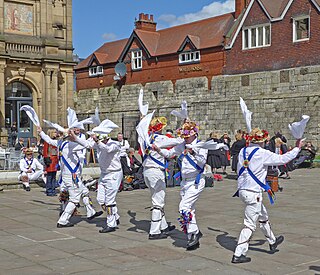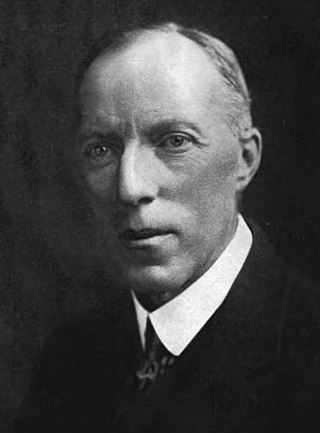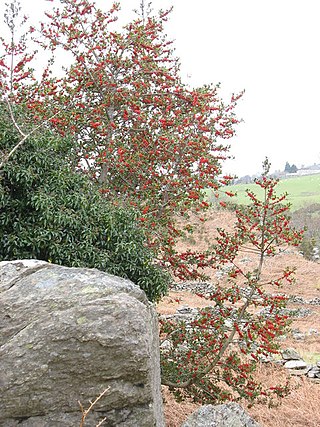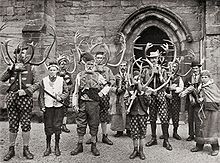
Morris dancing is a form of English folk dance. It is based on rhythmic stepping and the execution of choreographed figures by a group of dancers in costume, usually wearing bell pads on their shins and/or shoes. A band or single musician, also costumed, will accompany them. Sticks, swords, handkerchiefs, and a variety of other implements may be wielded by the dancers.

Abbots Bromley is a village and civil parish in the East Staffordshire district of Staffordshire and lies approximately 9.8 miles (15.8 km) east of Stafford, England. According to the University of Nottingham English Place-names project, the settlement name Abbots Bromley could mean 'clearing/wood frequented by broom'. The prefix 'abbots' was added because the village was held by Burton Abbey. The population of the civil parish at the 2011 census was 1,779.

Cecil James Sharp was an English collector of folk songs, folk dances and instrumental music, as well as a lecturer, teacher, composer and musician. He was a key figure in the folk-song revival in England during the Edwardian period. According to Roud's Folk Song in England, Sharp was the country's "single most important figure in the study of folk song and music."
English Folk Song Suite is one of English composer Ralph Vaughan Williams' most famous works. It was first published for the military band as Folk Song Suite and its premiere was given at Kneller Hall on 4 July 1923, conducted by Lt Hector Adkins. The piece was then arranged for full orchestra in 1924 by Vaughan Williams' student Gordon Jacob and published as English Folk Song Suite. The piece was later arranged for British-style brass band in 1956 by Frank Wright and published as English Folk Songs Suite. All three versions were published by Boosey & Hawkes; note the use of three different titles for the three different versions. The suite uses the melodies of nine English folk songs, six of which were drawn from the collection made by Vaughan Williams’ friend and colleague Cecil Sharp.

"The Holly and the Ivy" is a traditional British folk Christmas carol, listed as number 514 in the Roud Folk Song Index. The song can be traced only as far as the early nineteenth century, but the lyrics reflect an association between holly and Christmas dating at least as far as medieval times. The lyrics and melody varied significantly in traditional communities, but the song has since become standardised. The version which is now popular was collected in 1909 by the English folk song collector Cecil Sharp in the market town of Chipping Campden in Gloucestershire, England, from a woman named Mary Clayton.
"The Maid Freed from the Gallows" is one of many titles of a centuries-old folk song about a condemned maiden pleading for someone to buy her freedom from the executioner. Other variants and/or titles include "The Gallows Pole", "The Gallis Pole", "Hangman", "The Prickle-Holly Bush", "The Golden Ball", and "Hold Up Your Hand, Old Joshua She Cried." In the collection of ballads compiled by Francis James Child in the late 19th century, it is indexed as Child Ballad number 95; 11 variants, some fragmentary, are indexed as 95A to 95K. The Roud Folk Song Index identifies it as number 144.
Dives and Lazarus is traditional English folk song listed as Child ballad 56 and number 477 in the Roud Folk Song Index. It is considered a Christmas carol and based on the parable of the rich man and Lazarus. The song traditionally used a variety of tunes, but one particular tune, published by Lucy Broadwood in 1893 and used in other traditional songs, inspired many notable works and appeared in several pieces composed by Ralph Vaughan Williams.

In the coastal town of Minehead, located in the southwest English county of Somerset, there is a folk custom on May Day entailing the parading of a brightly decorated hobby horse around the locality.

A soul cake, also known as a soulmass-cake, is a small round cake which is traditionally made for Halloween, All Saints' Day and All Souls' Day to commemorate the dead in many Christian traditions. The cakes, often simply referred to as souls, are given out to soulers who go from door to door during the days of Allhallowtide singing and saying prayers "for the souls of the givers and their friends", especially the souls of deceased relatives, thought to be in Purgatory. The practice in England dates to the medieval period, and was continued there until the 1930s. In Sheffield and Cheshire, the custom has continued into modern times. In Lancashire and in the North-east of England soul cakes were known as Harcakes, a kind of thin parkin.

"The Derby Ram" or "As I was Going to Derby" is a traditional tall tale English folk song that tells the story of a ram of gargantuan proportions and the difficulties involved in butchering, tanning, and otherwise processing its carcass.

The Dorset Ooser is a wooden head that featured in the 19th-century folk culture of Melbury Osmond, a village in the southwestern English county of Dorset. The head was hollow, thus perhaps serving as a mask, and included a humanoid face with horns, a beard, and a hinged jaw which allowed the mouth to open and close. Although sometimes used to scare people during practical jokes, its main recorded purpose was as part of a local variant of the charivari custom known as "skimity riding" or "rough music", in which it was used to humiliate those who were deemed to have behaved in an immoral manner.

In folklore, a hobby horse is a costumed character that features in some traditional seasonal customs, processions and similar observances around the world. In England, they are particularly associated with May Day celebrations, mummers' plays and the Morris dance.

Castleton Garland Day or Garland King Day is held annually on 29 May in the town of Castleton in the Derbyshire Peak District. The Garland King, on horseback, and covered to the waist in a heavy, bell-shaped floral garland, leads a procession through the town.

"Rain and Snow", also known as "Cold Rain and Snow", is an American folksong and in some variants a murder ballad. The song first appeared in print in Olive Dame Campbell and Cecil Sharp's 1917 compilation English Folk Songs from the Southern Appalachians, which relates that it was collected from Mrs. Tom Rice in Big Laurel, North Carolina in 1916. The melody is pentatonic.
Violet Alford was an internationally recognised authority on folk dancing and its related music, costume, and folk customs. She believed that a common prehistoric root explained the similarities found across much of Europe.

Old Tup, sometimes termed the Derby Tup or the Derby Ram, is a folk custom found in an area of the East Midlands of England. Geographically, the custom was found on the borders of Derbyshire and Yorkshire and stretched into part of Nottinghamshire. The tradition entails the use of a hobby horse with a goat's head that is mounted on a pole and carried by an individual hidden under a sackcloth. It represents a regional variation of a "hooded animal" tradition that appears in various forms throughout the British Isles. In geographical location and style it displays strong similarities with the Old Horse custom, but in the latter the hobby horse was presented as a horse rather than a ram.
Old Ball is a folk custom that existed in the Forest of Rossendale in Lancashire, north-western England during the nineteenth century. The tradition entailed the use of a hobby horse that is mounted on a pole and carried by an individual hidden under a sackcloth. It represents a regional variation of a "hooded animal" tradition that appears in various forms throughout the UK.
The Wooing Play was a form of performance found in the folk culture of parts of east-central England.
The Gloucestershire Wassail, also known as "Wassail! Wassail! All Over the Town", "The Wassailing Bowl" and "Wassail Song" is an English Christmas carol from the county of Gloucestershire in England, dating back to at least the 18th century, but may be older.
High Germany, is a traditional folk song, once known throughout England, Ireland and Scotland, with a history spanning hundreds of years. There are three songs known as High Germany. This page focuses on the best known one, the others being The Two Lovers or True Lovers and The Wars of Germany.















